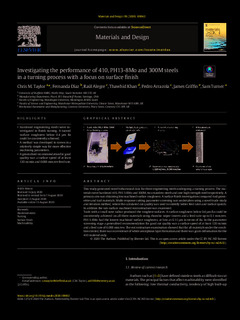| dc.rights.license | Attribution-NonCommercial-NoDerivatives 4.0 International | * |
| dc.contributor.author | Alegre García, Raul | |
| dc.contributor.author | ARRAZOLA, PEDRO JOSE | |
| dc.contributor.other | Taylor, Chris M. | |
| dc.contributor.other | Díaz, Fernanda | |
| dc.contributor.other | Khan, Thawhid | |
| dc.contributor.other | Griffin, James | |
| dc.contributor.other | Turner, Sam | |
| dc.date.accessioned | 2020-09-02T10:06:09Z | |
| dc.date.available | 2020-09-02T10:06:09Z | |
| dc.date.issued | 2020 | |
| dc.identifier.issn | 0264-1275 | en |
| dc.identifier.other | https://katalogoa.mondragon.edu/janium-bin/janium_login_opac.pl?find&ficha_no=159514 | en |
| dc.identifier.uri | https://hdl.handle.net/20.500.11984/1809 | |
| dc.description.abstract | This study generated novel behavioural data for three engineering steels undergoing a turning process. The materialswere hardened 410, PH13-8Mo and 300M, two stainless steels and one high strength steel respectively. A primary aimwas obtaining lowmachined surface roughness. A surface finish investigation compared tool geometries and tool materials.Multi-response cutting parameter screening was undertaken using a novel trade study
and iteration method, where the calculated cut quality was used to identify better feed rates and surface speeds.
In addition the sub-surface machined microstructure was examined.
Tools with a small nose radius produced the roughest surfaces. A surface roughness below 0.4 μm Ra could be consistently achieved on all three materials using rhombic wiper inserts and a feed rate up to 0.1 mm/rev. PH13-8Mo had the lowest machined surface roughness, as low as 0.11 μm in terms of Ra. In the parameter screening stage a generalised recommendation for good cut quality was a surface speed of at least 120 m/min
and a feed rate of 0.088mm/rev. The microstructure examination showed that for all materials under the conditions tested, therewas no evidence ofwhite amorphous layer formation and therewas grain deformation for the 410 material only. | en |
| dc.description.sponsorship | Tata Steel | es |
| dc.description.sponsorship | Universidad de Chile | es |
| dc.language.iso | eng | en |
| dc.publisher | Elsevier Ltd. | en |
| dc.rights | © 2020 The Authors | en |
| dc.rights.uri | http://creativecommons.org/licenses/by-nc-nd/4.0/ | * |
| dc.subject | Hardened steels | en |
| dc.subject | Turning | en |
| dc.subject | Surface finish | en |
| dc.subject | Machinability | en |
| dc.title | Investigating the performance of 410, PH13-8Mo and 300M steelsin a turning process with a focus on surfacefinish | en |
| dc.type | http://purl.org/coar/resource_type/c_6501 | |
| dcterms.accessRights | http://purl.org/coar/access_right/c_abf2 | en |
| dcterms.source | Materials & Design | en |
| local.contributor.group | Mecanizado de alto rendimiento | es |
| local.description.peerreviewed | true | en |
| local.identifier.doi | https://doi.org/10.1016/j.matdes.2020.109062 | en |
| local.rights.publicationfee | APC | en |
| local.rights.publicationfeeamount | 1854 EUR (2200 USD) | en |
| local.contributor.otherinstitution | https://ror.org/05krs5044 | es |
| local.contributor.otherinstitution | https://ror.org/047gc3g35 | es |
| local.contributor.otherinstitution | https://ror.org/02hstj355 | es |
| local.contributor.otherinstitution | https://ror.org/01tgmhj36 | es |
| local.source.details | Vol. 195. N. art. 109062, 2020 | en |
| oaire.format.mimetype | application/pdf | |
| oaire.file | $DSPACE\assetstore | |
| oaire.resourceType | http://purl.org/coar/resource_type/c_6501 | en |
| oaire.version | http://purl.org/coar/version/c_970fb48d4fbd8a85 | en |








